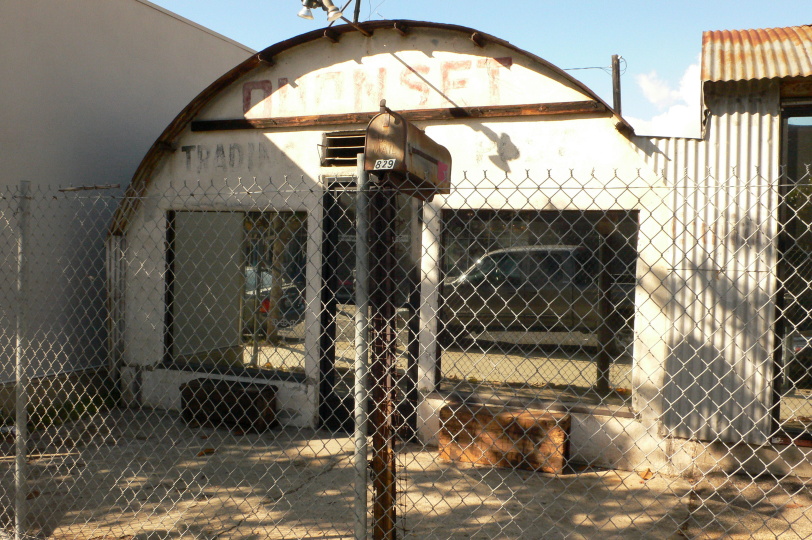| The LookOut columns | | What I Say |
| The LookOut columns | | What I Say |
|
|
 |
| Quonset hut at 829 Broadway. (Photo by Frank Gruber) |
Santa Monicans will remember the hut as having been an odds and ends and surplus store.
If you read the staff reportfor the Quonset Hut, and a consultant's report, you will learn about the history of Quonset Huts, which were, like the bulldozer and penicillin, one of those crucial non-lethal weapons the U.S. military wielded in World War II.
During the war, more than 150,000 Quonset Huts were manufactured. They are said to be an example of Bauhaus type modernism -- because their form followed function -- but in fact the design originated with the British "Nissen hut" of World War I [http://www.nissens.co.uk/default.htm]. After the war, surplus Quonset Huts were sold off for $1,000, and two of them ended up in an L-shaped configuration at Ninth and Broadway. Planning staff is only recommending that one of the huts, the more westerly one, be landmarked because the other hut has been altered extensively.
Under Santa Monica's Landmarks Ordinance, there are six criteria by which the City may declare a building to be a landmark. Any one will suffice.
Staff and the consultant have determined that because the Quonset hut on Broadway appears to be the last in the city, it qualifies under one criterion, number four: "[the Quonset hut] embodies distinguishing architectural characteristics valuable to a study of a period, style, method of construction, or the use of indigenous materials or craftsmanship, or is a unique or rare example of an architectural design, detail or historical type valuable to such a study."
There is something missing in this analysis -- context. Quonset huts reflect a period, a style, and a method of construction, but what do Quonset huts have to do with Santa Monica? This is not a question that typically arises under our landmarks law. The Landmarks Commission usually evaluates buildings or other structures that are naturally part of Santa Monica's historical fabric, since they are stuck on the ground here.
But what about a structure that was fabricated somewhere else, plunked down here, and which derives its historical importance from its relationship to events that had no special relationship to Santa Monica? World War II affected Santa Monica more than most places, true, but the issue is not whether to landmark the (now torn down) Douglas plant, or, for that matter, a DC-3 that someone parked on a vacant lot and turned into a store.
Should an old Airstream trailer in someone's backyard be a Santa Monica landmark?
Planning staff must recognize the context problem, because staff found that the historical significance of the hut "was not tied to its geographic location." For that reason, staff did not recommend that the property be designated as a landmark, only the hut.
As is often the case, the proposal to landmark the Quonset hut arose because a developer wants to demolish it -- in this case to build a four-story building with 129 affordable single apartments. If the Landmarks Commission accepts the staff's suggestions, and landmarks the structure but not the property, then presumably the developer can satisfy the law by moving the hut -- much as the Ocean Park shotgun house has been moved around.
But that just highlights the context issue -- the shotgun house is part of Santa Monica's history, and the meaningful thing to do is to find a place for it in Santa Monica. The Quonset hut, however, would have more meaning somewhere else -- at a naval museum, for instance. In fact, the SEABEES Museum [http://www.seabeesmuseum.com/Quonset_Huts.html] in Davisville, Rhode Island, near where Quonset huts were designed and first fabricated, already has several better examples of Quonset huts on display. (Quonset huts are not rare outside of Santa Monica.)
Was the intent of Santa Monica's landmarks law was to turn Santa Monica into America's attic?
* * *
The planning department's latest workshop on transportation -- last Thursday evening at the Civic Auditorium -- was another well-attended affair. The participants moved the city further in the direction of developing more holistic measurements of and goals for mobility.
However, the department still needs to address the issue that probably interests most Santa Monicans regardless whether they worship the automobile or damn it as the work of the Devil: how can we reduce traffic by persuading car commuters to take transit?
Fortunately, at the end of the workshop, when planning commissioners had their say, Commissioner Gleam Davis made the point that the City needs to do exactly that. Planning staff and their colleagues at the Big Blue Bus need to meet with Santa Monica's major employers and their employees to figure out how to convert the money they are now spending on parking into bus and shuttle systems that employees can use right now -- regardless what happens with the Expo line and the Wilshire subway.
Santa Monica now proudly is the location for the Southern California headquarters for both Yahoo! and Google. Both of these companies run extensive transportation systems for their employees at their Silicon Valley offices. It's time both to tap into their expertise and to coax them into developing similar systems here.
|
If readers want to write the editor about this column, send your emails to The Lookout at mail@surfsantamonica.com . |
|
If readers want to write Frank Gruber, email frank@frankjgruber.net
The views
expressed in this column are those of Frank Gruber and do not necessarily
reflect the opinions of |
| Copyright 1999-2008 surfsantamonica.com. All Rights Reserved. |